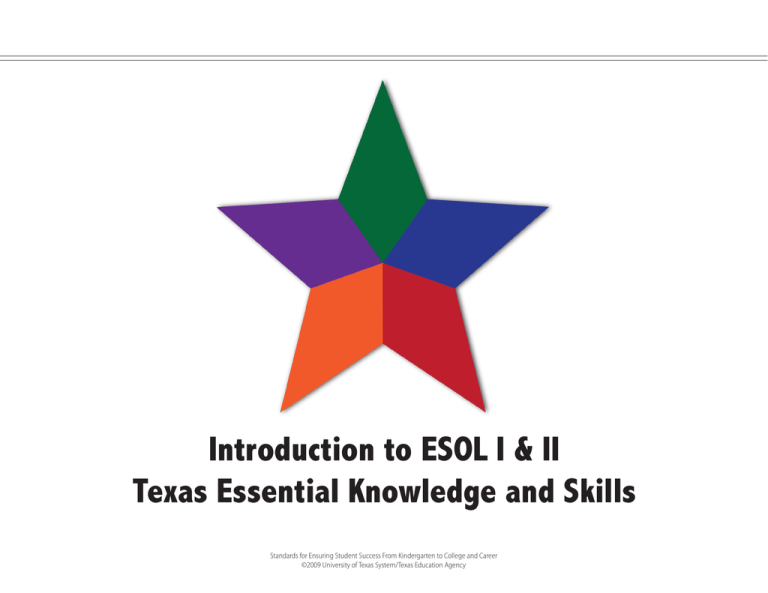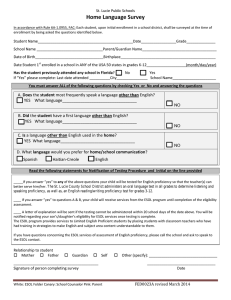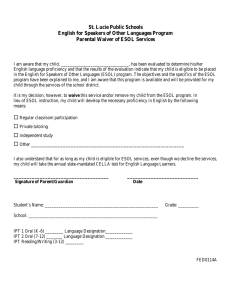Introduction to ESOL I & II Texas Essential Knowledge and Skills
advertisement

Introduction to ESOL I & II Texas Essential Knowledge and Skills Standards for Ensuring Student Success From Kindergarten to College and Career ©2009 University of Texas System/Texas Education Agency About the ESOL TEKS The English for Speakers of Other Languages I–II Texas Essential Knowledge and Skills (ESOL I–II TEKS) contains two sections: (a) Introduction and (b) Knowledge and skills. The information in section (b), Knowledge and skills, can also be found in the English I–II TEKS and the English Language Proficiency Standards (ELPS). Section (a), the Introduction, contains specific information about English language learners (ELLs) that is not included in the other documents. For this reason, this document (designed for training purposes) contains only the Introduction section of the ESOL I–II TEKS. Please refer to the English I–II TEKS and the ELPS for the other sections. Introduction Section The Introduction section contains important information about English language learners. Strands of the ESOL I–II TEKS The ESOL I–II TEKS Knowledge and skills section is divided into six strands: • • • • • • Reading (identical to the English I–II ELAR TEKS) Writing (identical to the English I–II ELAR TEKS) Oral and Written Conventions (identical to the English I–II ELAR TEKS) Research (identical to the English I–II ELAR TEKS) Listening and Speaking (identical to the English I–II ELAR TEKS) Second language acquisition (parallel to section (c) of the ELPS) The rule text for ESOL I TEKS and the ESOL II TEKS can be accessed through the TEA Web site, http://ritter.tea.state.tx.us/rules/tac/chapter128/index.html. Standards for Ensuring Student Success From Kindergarten to College and Career ©2009 University of Texas System/Texas Education Agency A note about the structure and wording of the ESOL I & II Introduction: The TEKS Introduction is identically worded for both ESOL I & II with a few exceptions. These exceptions are marked with numbered footnotes in the text on the next pages. We use ESOL I as the basis for our example. Texas Administrative Code (TAC), Title 19, Part II Chapter 128. Texas Essential Knowledge and Skills for Spanish Language Arts and Reading and English as a Second Language Subchapter C. High School Statutory Authority: The provisions of this Subchapter C issued under the Texas Education Code, §§7.102(c)(4), 28.002, 28.005, 28.025, and 29.051, unless otherwise noted. §128.30. Implementation of Texas Essential Knowledge and Skills for English as a Second Language, High School, Beginning with School Year 2009-2010. (a) The provisions of §128.31 and §128.32 of this subchapter shall be implemented by school districts beginning with the 2009-2010 school year and at that time shall supersede §128.42 and §128.43 of this subchapter. (b) Students must develop the ability to comprehend and process material from a wide range of texts. Student expectations for Reading/Comprehension Skills as provided in this subsection are described for the appropriate grade level. Figure: 19 TAC §128.30(b) Source: The provisions of this §128.30 adopted to be effective November 26, 2008, 33 TexReg 9465. Standards for Ensuring Student Success From Kindergarten to College and Career ©2009 University of Texas System/Texas Education Agency ESOL I & II TEKS Introduction | 1 §128.311. English I2 for Speakers of Other Languages (One Credit), Beginning with School Year 2009-2010. (a) Introduction. (1) The essential knowledge and skills as well as the student expectations for English I3 for Speakers of Other Languages (ESOL I4) are described in §74.4 of this title (relating to English Language Proficiency Standards) as well as subsection (b) of this section and are identical to the knowledge and skills and student expectations in Chapter 110 of this title (relating to Texas Essential Knowledge and Skills for English Language Arts and Reading) with additional expectations for English language learners (ELLs). (2) ESOL I5 may be substituted for English I6 as provided by Chapter 74, Subchapter B, of this title (relating to Graduation Requirements). All expectations apply to ESOL I7 students; however, it is imperative to recognize critical processes and features of second language acquisition and to provide appropriate instruction to enable students to meet these standards. (3) ELLs are expected to meet standards in a second language that many monolingual English speakers find difficult to meet in their native language. In addition, ELLs are acquiring English at the same time they are learning content in English. ELLs’ abilities to meet these standards will be influenced by their proficiency in English. While ELLs can analyze, synthesize, and evaluate, their level of English proficiency may impede their ability to demonstrate this knowledge during the initial stages of English language acquisition. For this reason, comprehension of text requires additional scaffolds that include adapted text (e.g., appropriate for student proficiency level; translations), pictures, realia, glossaries, bilingual dictionaries, thesaurus, and other modes of comprehensible input. ELLs can and should be encouraged to use their knowledge of their first language (e.g., cognates) to enhance their vocabulary development, and vocabulary needs to be in the context of connected discourse so that it is meaningful. Strategic use of the student’s first language is important to ensure linguistic, affective, cognitive, and academic development in English. 1 §128.32 in ESOL II 2 English II in ESOL II 3 English II in ESOL II 4 ESOL II in ESOL II 5 ESOL II in ESOL II 6 English II in ESOL II 7 ESOL II in ESOL II Standards for Ensuring Student Success From Kindergarten to College and Career ©2009 University of Texas System/Texas Education Agency ESOL I & II TEKS Introduction | 2 (4) Research consistently shows that a strong foundation in the native language of an ELL facilitates learning in English (Collier & Thomas, 1997; Cummins, 2001). Students can develop cognition, learn, and achieve best when they can understand the language of instruction (August, Calderon, & Carlo, 2003). Students can be expected to transfer those skills to English and progress rapidly in learning in English. (5) For newcomers in secondary schooling, the challenge then is not only learning English, but learning in English. ELLs are challenged in working with linguistic, cognitive, and academic development in all of their coursework and in a new language. Some newcomers exhibit additional first language and/or academic needs due to their previous educational experiences that may include interrupted and/or limited schooling. Strategic use of the student’s first language is important to ensure linguistic, affective, cognitive, and academic development in English, especially for students who are newcomers and at beginning levels of English language proficiency. Their academic success depends on their ability to use academic language. (6) Second language acquisition is a complex process that even under optimal conditions takes a long time (Collier, 1997). It is important to understand that limited knowledge of English structure and vocabulary is neither related to the students’ intellectual capabilities nor their ability to use higher-order thinking skills. The development of receptive (listening/reading) and expressive (speaking/writing) skills in second language learners may be at different stages. In some instances, second language learners undergo silent periods of varying durations when they first begin to learn a new language. Students often understand more than they can produce and may repeat words in sentences that they do not entirely understand. Second language learners may also draw upon the resources of their language and culture as they acquire a new language and culture. (7) In order for ELLs to be successful, they must acquire both social and academic language proficiency in English. Social language proficiency in English consists of the English needed for daily social interactions. Academic language proficiency consists of the English needed to think critically, understand and learn new concepts, process complex academic material, and interact and communicate in English academic settings. (8) Academic language is a major factor in academic success. Academic language and grammatical structures are used across all subject areas and is specific to the content area, such as language arts, mathematics, science, and social studies. Current research stresses the importance of effectively integrating second language acquisition with quality content area education in order to ensure that ELLs acquire social and academic language proficiency in English, learn the knowledge and skills, and reach their full academic potential. This must also be provided in a manner that is linguistically accommodated (contextualized, communicated, sequenced, and scaffolded) commensurate with the student’s levels of English language proficiency to ensure that the student learns the knowledge and skills in the required curriculum. Standards for Ensuring Student Success From Kindergarten to College and Career ©2009 University of Texas System/Texas Education Agency ESOL I & II TEKS Introduction | 3 (9) ELLs require focused, targeted, and systematic second language acquisition to provide them with the foundation of English language vocabulary, grammar, syntax, and English mechanics necessary to support content-based instruction and accelerated learning of English. Literacy development across the content areas is essential in building academic skills in a second language and can accelerate the learning of both English language skills and higher-order thinking skills. (10) ELL students are at different stages of language acquisition. Proficiency levels are not grade specific: Beginning, Intermediate, Advanced, and Advanced High. The ELL student may exhibit different proficiency levels within the four language components: listening, speaking, reading, and writing. A student may exhibit oral skills at the advanced level, reading skills at the intermediate level, and writing skills at the beginning level. Understanding the level of English language proficiency of the student is critical in order for the student to have access to the curriculum. The proficiency level of the student determines the accommodations in language that must be made (e.g., adapted text appropriate for student proficiency level; translations) as well as, determines additional scaffolds (e.g., pictures, realia, glossaries, bilingual dictionaries, thesaurus) in order to learn the academic content. Any combination of the language components is possible and is affected by opportunities for interaction in and outside of school. For further guidance in second language acquisition, refer to the English language proficiency standards (ELPS) described in §74.4 of this title. (A) Beginning: Students associate utterances with meaning as they make inferences based on actions, visuals, text, tone of voice, and inflections. Receptive language with some comprehension is acquired earlier than oral production. Beginning students produce spoken English with increasing accuracy and fluency to convey appropriate meaning. They read English using graphophonic cues, syntax, visuals, the context of the text, and their prior knowledge of language and structure of text. (B) Intermediate: Students use the listening process to improve comprehension and oral skills in English. Through listening and speaking in meaningful interactions, they clarify, distinguish, and evaluate ideas and responses in a variety of situations. Intermediate students participate successfully in academic, social, and work contexts in English using the process of speaking to create, clarify, critique, and evaluate ideas and responses. Intermediate students read English using and applying developmental vocabulary to increase comprehension and produce written text to address a variety of audiences and purposes. (C) Advanced: Students, through developmental listening skills, actively expand their vocabulary to evaluate and analyze spoken English for a variety of situations and purposes. These students participate in a variety of situations using spoken English to create, clarify, critique, and evaluate ideas and responses. Advanced students continually develop reading skills for increasing reading proficiency in content area texts for a variety of purposes and generate written text for different audiences in a variety of modes to convey appropriate meaning according to their level of proficiency. Standards for Ensuring Student Success From Kindergarten to College and Career ©2009 University of Texas System/Texas Education Agency ESOL I & II TEKS Introduction | 4 (D) Advanced High: Students’ reading, speaking, and writing abilities are comparable to those of their native English speaking peers. They understand grade appropriate English as it is used in academic and social settings. These students use language skills on their grade level in the academic subject areas with minimal interruptions and they use abstract and content based vocabulary effectively. Advanced High students continually use the English language to build additional foundational reading skills such as fluency and prosody as well as higher-order comprehension skills. These students have a strong command of English language structures necessary to address writing at appropriate grade levels. (11) Students enrolled in ESOL I8 continue to increase and refine their communication skills. High school students are expected to plan, draft, and complete written compositions on a regular basis. Students edit their papers for clarity, engaging language, and the correct use of the conventions and mechanics of written English and, with increasing accuracy, produce final, error-free drafts. In English I9, students practice all forms of writing. An emphasis is placed on organizing logical arguments with clearly expressed related definitions, thesis, and evidence. Students write to persuade and to report and describe. English I10 students read extensively in multiple genres from world literature such as reading selected stories, dramas, novels, and poetry originally written in English or translated to English from oriental, classical Greek, European, African, South American, and North American cultures. Students learn literary forms and terms associated with selections being read. Students interpret the possible influences of the historical context on a literary work. (12) The knowledge and skills and/or student expectations that are applicable specifically to ELLs are indicated in §74.4 of this title as well as in subsection (b) of this section. (13) To meet Public Education Goal 1 of the Texas Education Code, §4.002, which states, “The students in the public education system will demonstrate exemplary performance in the reading and writing of the English language,” students will accomplish the essential knowledge and skills as well as the student expectations in English I11 as described in subsection (b) of this section. (14) To meet Texas Education Code, §28.002(h), which states, “... each school district shall foster the continuation of the tradition of teaching United States and Texas history and the free enterprise system in regular subject matter and in reading courses and in the adoption of textbooks,” students will be provided oral and written narratives as well as other informational texts that can help them to become thoughtful, active citizens who appreciate the basic democratic values of our state and nation. 8 ESOL II in ESOL II 9 English II in ESOL II 10 English II in ESOL II 11 English II in ESOL II Standards for Ensuring Student Success From Kindergarten to College and Career ©2009 University of Texas System/Texas Education Agency ESOL I & II TEKS Introduction | 5





